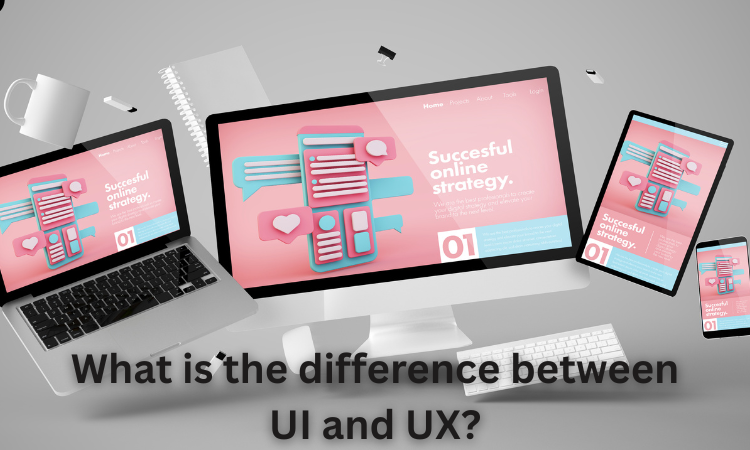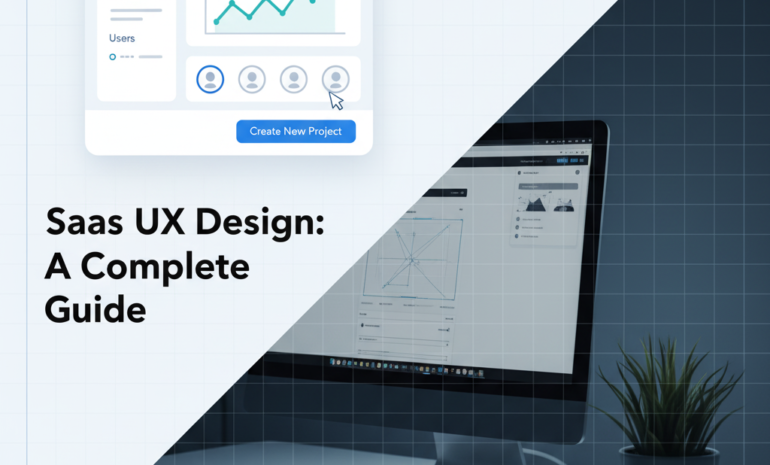UX goes beyond visuals, shaping how people interact with products and services. Whether it’s an app, website, or digital tool, a well-designed user experience can make the difference between frustration and satisfaction.
Businesses that get UX right don’t just attract users, they keep them. So, what is UX, what makes UX design so important, and why should it be a priority? Let’s take a closer look.
What is User Experience (UX)?
User Experience (UX) is how a person feels when interacting with a product, website, or app. It’s about making things simple, intuitive, and enjoyable so users can get what they need without frustration.
Good UX ensures a product is easy to use, solves real problems, and feels natural.
UX design is the process of shaping this experience by understanding users, eliminating obstacles, and designing smooth, meaningful interactions that keep people coming back.

Importance of First Impressions
First impressions matter, especially in user experience (UX). When users interact with a product, website, or app for the first time, their initial experience shapes their perception of the brand.
A well-designed UX ensures that this first interaction is seamless, engaging, and intuitive, increasing the chances of user retention.
A smooth and visually appealing interface builds trust, encourages exploration, and reduces bounce rates by making navigation effortless.
When users find interactions easy and frustration-free, they are more likely to stay, engage, and take meaningful actions.
A strong first impression not only enhances credibility but also influences decision-making, fostering long-term satisfaction and loyalty.
Why is UX design so important?
Let’s explore key reasons that can help convince management of the importance of UX design in enhancing customer retention and driving business success.
Enhance User Satisfaction for a Better Experience
A user-oriented UX ensures a seamless and enjoyable experience, keeping users happy and engaged. When interactions are smooth and intuitive, users feel more comfortable navigating a product, reducing frustration and confusion.
A positive experience increases user confidence, making them more likely to return and recommend the product to others.
By prioritizing user needs, simplifying tasks, and ensuring ease of use, UX design fosters satisfaction, ultimately leading to higher retention rates and long-term brand loyalty.
Improve Usability for Flawless Interaction
A well-structured UX design ensures that users can navigate a product effortlessly and access the information they need without confusion.
Clear layouts, intuitive menus, and logical content placement make interactions smooth and efficient. When users can complete tasks with minimal effort, they feel more satisfied and engaged.
Improving usability reduces frustration, increases accessibility, and enhances the overall experience for all users, including those with disabilities. A product that is easy to use keeps users coming back, boosting engagement and retention.
Boost Engagement Through Thoughtful Design
Visually appealing and interactive designs capture user attention and encourage longer interactions. Smooth navigation, engaging visuals, and intuitive layouts make the experience delightful, keeping users interested.
When content is easy to explore and interactions feel natural, users are more likely to stay on a website or app instead of leaving.
A seamless UX fosters curiosity and encourages users to interact with different features, increasing overall engagement. Higher engagement levels ultimately lead to better retention and stronger connections with the brand.

Increase Conversions with User-Centered Design
A well-designed app or website makes it easy for users to find what they need. When navigation is smooth and interactions feel effortless, people are more likely to complete purchases or sign up.
Confusing layouts or slow-loading pages, on the other hand, drive users away. A clear, intuitive experience builds trust and keeps visitors engaged, increasing the chances of conversions.
Small improvements in usability can lead to significant growth in sales and customer retention.
Reduce Bounce Rate with Intuitive Layouts
A cluttered or confusing interface frustrates visitors, making them leave quickly. When a website is easy to navigate, with clear menus and well-structured content, users stay longer and explore more.
Smooth interactions and fast load times also keep engagement high. The more comfortable people feel using a site, the less likely they are to abandon it, leading to lower bounce rates and better overall performance.
Build Brand Loyalty Through Consistency
When users have a smooth and enjoyable experience, they’re more likely to come back. A clean design, easy navigation, and helpful features create a positive impression.
People remember brands that make their lives easier, which builds trust and loyalty over time. If a mobile app or website feels frustrating, users will look for alternatives.
A strong UX keeps customers engaged, encouraging repeat visits and long-term relationships with the brand.
Save Time and Effort for Users
A well-structured design helps users complete tasks with minimal effort. Clear navigation, logical layouts, and intuitive features ensure they don’t waste time searching for information.
When everything flows smoothly, frustration decreases, and satisfaction increases. Whether it’s making a purchase or finding key details, a streamlined experience keeps users engaged and prevents them from leaving out of frustration. The easier it is to use, the more likely people are to return.

Ensure Accessibility for Inclusive Design
Good UX design ensures that everyone, including people with disabilities, can use a website or app without difficulty. Features like readable fonts, keyboard navigation, and screen reader support make digital products more inclusive.
When accessibility is a priority, more users can engage comfortably, leading to better experiences for all. A design that considers diverse needs not only broadens the audience but also reflects a brand’s commitment to inclusivity and user satisfaction.
Improve SEO with UX Best Practices
A well-designed website isn’t just good for users, it’s good for search engine rankings as well. Fast load times, mobile-friendly layouts, and easy navigation help search engines understand and index content better.
When users stay longer and interact more, it signals quality to search engines, boosting rankings. A smooth experience reduces bounce rates and increases engagement, both key factors in SEO. Better UX leads to better search engines visibility, bringing in more organic traffic.
Reduces Development Costs with Smart Planning
Addressing UX problems during the design phase prevents costly fixes later. A well-planned user experience reduces the need for frequent redesigns, bug fixes, and support requests.
When users can navigate smoothly, there are fewer complaints and less need for customer assistance. Investing in good UX from the start not only saves money but also speeds up development, ensuring a polished product that meets user needs without costly rework.
Strengthen Brand Image Through UX
A seamless user experience makes a brand look trustworthy and professional. When a mobile application or website is easy to use, visually appealing, and free of frustrations, it leaves a positive impression.
Users associate a smooth experience with quality and reliability, increasing their confidence in the brand. On the other hand, a poorly designed interface can make a company seem unprofessional. A strong UX builds credibility and sets a brand apart from competitors.
Increase Customer Retention with Great UX
Increased customer retention comes from creating seamless, pleasant experiences that keep users engaged. When interactions are intuitive and hassle-free, users feel more comfortable and confident navigating a product.
Positive experiences build trust and encourage repeat visits, reducing the likelihood of users switching to competitors. Smooth navigation, clear call-to-actions, and aesthetically pleasing interfaces contribute to user satisfaction.
Consistency in design and functionality fosters familiarity, making it easier for customers to return and stay loyal over time.
Lower Support Costs with Clear Interfaces
Reducing support costs starts with a well-structured and easy-to-navigate interface. When users can find information effortlessly and complete tasks without frustration, they are less likely to seek customer support.
Clear instructions, intuitive layouts, and self-service options like FAQs or chatbots minimize the need for assistance.
Fewer support requests mean reduced workload for customer service teams, allowing resources to be allocated more efficiently. An effective UX not only enhances user satisfaction but also leads to significant cost savings for businesses.
Encourages Word-of-Mouth Marketing
When users have a great experience, they naturally share it with others. A artistically-designed website or app makes interactions smooth and satisfying, leading to positive reviews and recommendations.
People trust personal referrals, so good UX can drive organic growth without extra marketing costs. On the other hand, frustrating experiences lead to complaints and negative feedback.
Investing in UX turns satisfied users into brand advocates who spread the word and attract more customers.
Gain Competitive Advantage with Better UX
Standing out in a crowded market requires more than just a good product, exceptional user experience makes the difference.
A seamless, visually appealing, and intuitive interface attracts and retains customers, giving businesses an edge over competitors.
When users find a platform easy to navigate and enjoyable to use, they are more likely to choose it over alternatives.
Strong UX design builds brand loyalty, enhances reputation, and increases word-of-mouth recommendations, making it a powerful tool for long-term success.
Optimize Mobile Experience for On-the-Go Users
With the growing dominance of mobile usage, ensuring a smooth experience across all devices is crucial. Responsive design, fast load times, and touch-friendly interfaces create a frictionless journey for users.
A mobile-optimized UX adapts to different screen sizes, making navigation effortless and interactions seamless.
Prioritizing mobile usability improves engagement, reduces bounce rates, and increases conversions, ensuring that users can access products or services anytime, anywhere without frustration.
Supports Business Goals
Effective UX design bridges the gap between user needs and company objectives. When a product is easy to use and meets customer expectations, it drives higher engagement, conversions, and revenue.
Strategic UX decisions guide users toward desired actions, such as making a purchase or signing up for a service.
Aligning design with business goals ensures efficiency, customer satisfaction, and long-term success, making UX a crucial investment for growth and sustainability.

Prevent User Errors with Thoughtful Design
Cluttered interfaces and confusing navigation often lead to user mistakes, causing frustration and drop-offs. A well-structured design with clear labels, intuitive workflows, and error-prevention mechanisms helps users complete tasks correctly the first time.
Providing real-time feedback, undo options, and simple instructions further reduces mistakes. Fewer errors improve the overall user experience, boosting confidence and trust in the product while reducing the need for customer support.
Encourages Emotional Connection
A well-crafted user experience does more than just function, it makes people feel good. Smooth navigation, appealing visuals, and thoughtful interactions create a sense of ease and enjoyment.
When users feel valued and understood, they form a stronger connection with the brand. Positive emotions lead to lasting impressions, making users more likely to return and recommend the product.
A great UX isn’t just about usability; it’s about creating meaningful experiences that resonate.
Drive Revenue Growth with Optimized UX
A seamless user experience directly impacts a company’s bottom line. When users can navigate a product effortlessly and complete tasks without frustration, they are more likely to make purchases, subscribe to services, or engage with premium features.
Satisfied customers return more often and recommend the product to others, increasing customer acquisition and retention. Improved UX also reduces cart abandonment and boosts conversion rates, making it a powerful driver of long-term revenue growth.
What is the main goal of UX design?
The main goal of UX design is to make products easy, seamless, and valuable for people while aligning with business objectives. It’s all about creating smooth, frustration-free experiences so users can get what they need without confusion or hassle.
When a product feels natural to use, people are more likely to stick with it, come back, and even recommend it to others. At the same time, good UX helps businesses succeed by keeping customers happy and engaged.
Principles of UX Design
User Experience (UX) design is all about creating intuitive, enjoyable, and efficient interactions between users and a product. By following key principles, designers ensure that users have a smooth and meaningful experience.
User-Centered Design:
Designing with the user in mind means understanding their goals, pain points, and expectations. Research, feedback, and testing help create intuitive experiences that align with real user needs, improving satisfaction and engagement.
Clarity & Simplicity:
A clear and simple design makes it easier for users to find what they need without frustration. Straightforward navigation, intuitive layouts, and concise content enhance usability.
Avoiding clutter and unnecessary elements helps users focus on their tasks, leading to a more efficient and comfortable experience with minimal confusion.

Consistency:
A cohesive design across all pages and interactions builds familiarity and trust. When typography, colors, buttons, and navigation elements remain uniform, users can predict how things work, reducing cognitive load.
Consistency improves usability, enhances brand identity, and ensures a smooth, seamless experience across different sections of a platform or product.
Accessibility:
Creating an inclusive design means ensuring that all users, including those with disabilities, can interact with a product effortlessly. Features like alt text, keyboard navigation, and color contrast improve usability.
Prioritizing accessibility not only broadens the audience but also enhances the overall experience for everyone, making interactions smoother and more intuitive.
Feedback & Responsiveness:
Clear feedback reassures users that their actions have been recognized. Visual cues like button highlights, error messages, or success confirmations help prevent confusion.
Responsive design also ensures quick interactions, reducing wait times and frustration. Providing timely feedback keeps users informed, engaged, and confident while navigating a platform or completing tasks.
Efficiency & Speed:
A finely-designed UX helps users complete tasks quickly and effortlessly. Streamlining processes, reducing unnecessary steps, and optimizing page load speed enhance the overall experience.
Fast, intuitive interactions prevent frustration and keep users engaged. Prioritizing efficiency ensures that users can navigate, find information, and achieve their goals with minimal effort.

Visual Hierarchy:
Effective design guides users’ attention by strategically using size, contrast, spacing, and positioning. Highlighting key elements, such as calls to action or important messages, improves usability.
A clear visual structure helps users process information quickly, reducing cognitive load and making navigation more intuitive and engaging.
Flexibility & Adaptability:
A successful UX design seamlessly adjusts to different devices, screen sizes, and user preferences. Responsive layouts, scalable elements, and touch-friendly interactions ensure a smooth experience on desktops, tablets, and mobile devices.
Adaptability enhances accessibility and usability, allowing users to interact comfortably no matter how they access the platform.
Why is UX research important in UX design?
UX research is important because it helps understand user needs, behaviors, and pain points, ensuring the product or service is designed to meet those needs effectively.
It informs design decisions, improves usability, and enhances user satisfaction by identifying potential problems early.
UX research also reduces costs by preventing unnecessary features and design errors, and helps create products that align with both user expectations and business goals, ultimately leading to better user engagement and higher conversions.
What is the difference between UI and UX?
UI (User Interface) and UX (User Experience) are closely related but serve different purposes in the design process.

UI (User Interface)
UI refers to the visual elements of a product or service, such as buttons, icons, layout, typography, and colors. It’s about how the product looks and how users interact with it visually.
UX (User Experience)
UX focuses on the overall experience a user has with a product, including usability, functionality, and how easy or enjoyable it is to use. It’s concerned with the journey users go through to achieve their goals, ensuring the product is intuitive and satisfying to use.
In short, UI is about the design and look of the interface, while UX is about the overall experience and satisfaction of the user.
How Brandout Can Help You Create Seamless UX Designs?
Brandout’s expert UX design team focuses on crafting intuitive and engaging user experiences that resonate with your audience.
By understanding the needs and preferences of your users, Brandout’s UX design service creates seamless designs that drive higher engagement and conversions.
Let our team make your digital presence impactful with designs that not only look great but also provide exceptional user satisfaction.
Most Asked Questions Related to UX Design:
What are the major Benefits of UX design?
Great UX design makes products effortless and satisfying, keeping users engaged and returning. It boosts conversions, lowers support costs, and sets businesses apart from competitors.
Enhancing usability and streamlining tasks creates a smoother experience that strengthens brand trust and drives long-term success.
Why is UX important for a business?
UX design enhances customer satisfaction, increases retention, and drives higher conversions. A well-designed user experience reduces friction, making it easier for customers to interact with a product or service.
It also minimizes support costs and boosts brand reputation, ultimately leading to long-term business growth and success.
Why is UX more important than UI?
While UI (User Interface) focuses on the look and feel, UX (User Experience) ensures usability and functionality. A beautiful interface means little if users struggle to navigate it.
UX is more important because it defines how users interact with a product, ensuring a seamless and satisfying experience that keeps them engaged.
What is the purpose of a UX designer?
A UX designer’s role is to create intuitive, efficient, and delightful experiences for users. They conduct research, analyze user behavior, and design solutions that improve usability.
Their goal is to make digital products more accessible, functional, and aligned with both user needs and business goals.
What is UX design useful for?
UX design enhances websites, apps, software, and even physical products by improving usability and accessibility. It helps businesses boost customer satisfaction, increase conversions, reduce errors, and streamline processes.
A well-executed UX design leads to a more intuitive, engaging, and efficient user experience.
What is the value of UX design?
UX design adds value by improving user engagement, reducing frustration, and increasing customer loyalty. It drives higher revenue by making interactions more seamless and enjoyable.
Additionally, it lowers costs by identifying and fixing issues early, leading to a more efficient and profitable product.
Is UX design coding?
No, UX design is not primarily about coding. It focuses on research, user psychology, wireframing, and prototyping. However, some UX designers may have basic coding knowledge to better collaborate with developers and understand technical limitations.
Is UX design only digital?
No, UX design applies to both digital and physical products. While it is commonly associated with websites and apps, UX principles are also used in designing physical products, services, and even customer experiences in retail, transportation, and healthcare.




